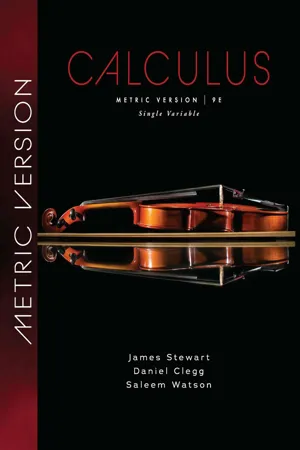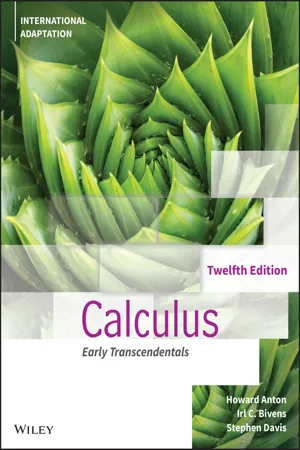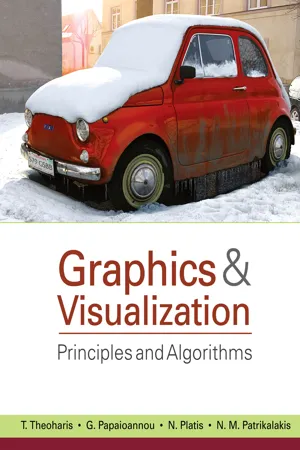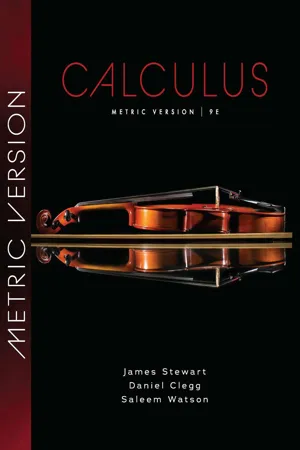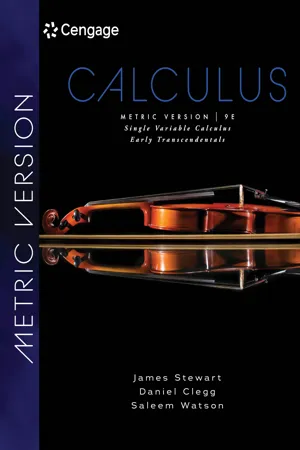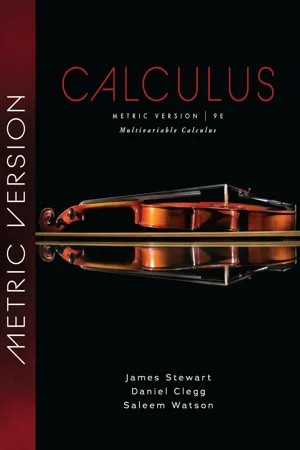Mathematics
Calculus of Parametric Curves
The calculus of parametric curves involves applying calculus techniques to curves defined by parametric equations. This includes finding derivatives, integrals, arc length, and curvature of parametric curves. It allows for the analysis of motion, such as the path of a moving object, and provides a powerful tool for solving problems in physics, engineering, and other fields.
Written by Perlego with AI-assistance
Related key terms
1 of 5
8 Key excerpts on "Calculus of Parametric Curves"
- eBook - PDF
- James Stewart, Daniel K. Clegg, Saleem Watson, , James Stewart, James Stewart, Daniel K. Clegg, Saleem Watson(Authors)
- 2020(Publication Date)
- Cengage Learning EMEA(Publisher)
All Rights Reserved. May not be copied, scanned, or duplicated, in whole or in part. Due to electronic rights, some third party content may be suppressed from the eBook and/or eChapter(s). Editorial review has deemed that any suppressed content does not materially affect the overall learning experience. Cengage Learning reserves the right to remove additional content at any time if subsequent rights restrictions require it. SECTION 10.2 Calculus with Parametric Curves 711 Calculus with Parametric Curves Having seen how to represent curves by parametric equations, we now apply the methods of calculus to these parametric curves. In particular, we solve problems involving tan- gents, areas, arc length, speed, and surface area. ■ Tangents Suppose f and t are differentiable functions and we want to find the tangent line at a point on the parametric curve x - f s t d, y - ts t d, where y is also a differentiable function of x. Then the Chain Rule gives dy dt - dy dx dx dt If dxydt ± 0, we can solve for dyydx : 1 dy dx - dy dt dx dt if dx dt ± 0 Equation 1 (which you can remember by thinking of canceling the dt’s) enables us to find the slope dyydx of the tangent to a parametric curve without having to eliminate the parameter t. We see from (1) that the curve has a horizontal tangent when dyydt - 0, provided that dxydt ± 0, and it has a vertical tangent when dxydt - 0, provided that dyydt ± 0. (If both dxydt - 0 and dyydt - 0, then we would need to use other methods to determine the slope of the tangent.) This information is useful for sketching paramet- ric curves. 10.2 If we think of the curve as being traced out by a moving particle, then dyydt and dxydt are the vertical and horizontal velocities of the particle and Formula 1 says that the slope of the tangent is the ratio of these velocities. 2. Use a graphing calculator or computer to draw the graphs of hypocycloids with a a positive integer and b - 1. - eBook - PDF
- Howard Anton, Irl C. Bivens, Stephen Davis(Authors)
- 2022(Publication Date)
- Wiley(Publisher)
PARAMETRIC AND POLAR CURVES; CONIC SECTIONS 9 windujedi/iStockphoto Mathematical curves, such as the spirals in the center of a sunflower, can be described conveniently using ideas developed in this chapter. In this chapter we will study alternative ways of expressing curves in the plane. We will begin by studying parametric curves: curves described in terms of component functions. This study will include methods for finding tangent lines to parametric curves. We will then introduce polar coordinate systems and discuss methods for finding tangent lines to polar curves, arc length of polar curves, and areas enclosed by polar curves. Our attention will then turn to a review of the basic properties of conic sections: parabolas, ellipses, and hyperbolas. Finally, we will consider conic sections in the context of polar coordinates and discuss some applications in astronomy. 9.1 PARAMETRIC EQUATIONS; TANGENT LINES AND ARC LENGTH FOR PARAMETRIC CURVES Graphs of functions must pass the vertical line test, a limitation that excludes curves with self-intersections or even such basic curves as circles. In this section we will study an alternative method for describing curves algebraically that is not subject to the severe restriction of the vertical line test. We will then derive formulas required to find slopes, tangent lines, and arc lengths of these parametric curves. We will conclude with an investigation of a classic parametric curve known as the cycloid. Parametric Equations Suppose that a particle moves along a curve C in the xy-plane in such a way that its x- and y-coordinates, as functions of time, are x = f (t), y = g (t) We call these the parametric equations of motion for the particle and refer to C as the trajectory of the particle or the graph of the equations (Figure 9.1.1). The variable t is called the parameter for the equations. - eBook - PDF
Graphics and Visualization
Principles & Algorithms
- T. Theoharis, Georgios Papaioannou, Nikolaos Platis, Nicholas M. Patrikalakis(Authors)
- 2008(Publication Date)
- A K Peters/CRC Press(Publisher)
7 Parametric Curves and Surfaces Equations are just the boring part of mathematics. I attempt to see things in terms of geometry. —Stephen Hawking 7.1 Introduction In Chapter 2 we presented algorithms for the rasterization of basic geometric primitives, lines and circles. However, the composition of realistic graphics scenes calls for more flexible, free-form curves and surfaces. The area of computer graphics that deals with these shapes is computer-aided geometric design (CAGD). In this chapter we shall examine representations and properties of the most basic forms of such curves and surfaces; the reader should refer to [Fari01, Hosc96, Bart87] for more advanced topics. The need for mathematical representations of free-form shapes, suitable for computer processing, became apparent during the 1960s in the automotive and aeronautic industries. Until that time, the specifications by the designers for the shape of cars and planes were implemented only approximately, as no exact de-scriptions of such shapes were in practical use. When computer-driven machinery that could produce complex-shaped objects was made available to these indus-tries, it became essential to devise suitable mathematical descriptions. Paul de Casteljau and Pierre B´ ezier, then working at Citro¨ en and Renault, respectively, developed independently the theory of polynomial curves and surfaces that now bears B´ ezier’s name—de Casteljau’s work was not published early on—and con-stitutes the basic tool for describing and rendering free-form shapes. 191 192 7. Parametric Curves and Surfaces All of the curve and surface descriptions examined in the rest of this Chap-ter are in parametric form, and the reader is referred to Appendix B (especially Sections B.1.1 and B.2.1) for an overview of the relevant background theory. - eBook - PDF
Calculus
Single Variable
- Carl V. Lutzer, H. T. Goodwill(Authors)
- 2011(Publication Date)
- Wiley(Publisher)
Chapter 9 Parametric Curves, Polar Coordinates, and Complex Numbers Planets moving around the sun, the flow velocity in an artery, the electromagnetic field around a wire, and many other phenomena have a naturally circular structure to them, so we describe them using polar coordinates. And when a situation re- quires several variables for its description, any or all of which change with time, we visualize it as a parametric curve. In this chapter we begin a discussion of these topics and combine them with the ideas and techniques of calculus. Additionally, we bring together the ideas of polar coordinates and infinite series in an introduction to complex numbers. 9.1 Parametric Curves 9.1 Parametric Curves . . . . . . . . . . 706 9.2 Calculus with Parametric Curves . . . . . . . . . 718 9.3 Polar Coordinates . . . . . . . . . . 730 9.4 Calculus in Polar Coordinates . . . . . . . . . . 745 9.5 Complex Numbers . . . . . . . . . . 752 Chapter Review . . . . . . . . . . . . . . . . 764 Projects & Applications . . . . . . . . 768 Imagine tracking yourself on a GPS device as you drive. Your coordinates change with time as you move, so let’s write them as x(t) and y(t). While the particulars of x(t) and y(t) will depend on when you speed up and slow down, the relationship between them is governed by the road. When a point moves in the plane, the path along which it travels (e.g. the road) is called a parametric curve, and the inde- The word parametric is pro- nounced “para-MET-rik,” and the word parameter is pro- nounced “puh-RAM-it-er.” pendent variable is called the parameter. Eliminating the parameter in a simple case Example 1.1. Describe the motion of the object whose coordinates change with time as follows: x(t) = 4t + 7 (1.1) y(t) = -3t + 9. (1.2) Solution: Since x 0 (t) = 4 is constant, the value of x is increasing at a constant rate Figure 1.1: The location of (x(t), y(t)) at times t = 1, 2, 3 as calculated from equations (1.1) and (1.2). - eBook - PDF
- James Stewart, Daniel K. Clegg, Saleem Watson, , James Stewart, James Stewart, Daniel K. Clegg, Saleem Watson(Authors)
- 2020(Publication Date)
- Cengage Learning EMEA(Publisher)
Due to electronic rights, some third party content may be suppressed from the eBook and/or eChapter(s). Editorial review has deemed that any suppressed content does not materially affect the overall learning experience. Cengage Learning reserves the right to remove additional content at any time if subsequent rights restrictions require it. SECTION 10.2 Calculus with Parametric Curves 715 Similarly, when applied to t, the Mean Value Theorem gives a number t i ** in st i21 , t i d such that Dy i - t9 st i ** d Dt Therefore | P i21 P i | - ssDx i d 2 1 sDy i d 2 - sf f 9 st i * d Dtg 2 1 f t9 st i ** d Dtg 2 - sf f 9 st i * dg 2 1 f t9 st i ** dg 2 Dt and so 4 L - lim n l` o n i-1 sf f 9 st i * dg 2 1 f t9 s t i ** dg 2 Dt The sum in (4) resembles a Riemann sum for the function sf f 9 s t dg 2 1 f t9 s t dg 2 but it is not exactly a Riemann sum because t i * ± t i ** in general. Nevertheless, if f 9 and t9 are continuous, it can be shown that the limit in (4) is the same as if t i * and t i ** were equal, namely, L - y sf f 9 s t dg 2 1 f t9 s t dg 2 dt Thus, using Leibniz notation, we have the following result, which has the same form as Formula 3. 5 Theorem If a curve C is described by the parametric equations x - f s t d, y - ts t d, < t < , where f 9 and t9 are continuous on f, g and C is traversed exactly once as t increases from to , then the length of C is L - y Î S dx dt D 2 1 S dy dt D 2 dt Notice that the formula in Theorem 5 is consistent with the general formula L - y ds of Section 8.1, where 6 ds - ÎS dx dt D 2 1 S dy dt D 2 dt EXAMPLE 4 If we use the representation of the unit circle given in Example 10.1.2, x - cos t y - sin t 0 < t < 2 then dxydt - 2sin t and dyydt - cos t, so Theorem 5 gives L - y 2 0 Î S dx dt D 2 1 S dy dt D 2 dt - y 2 0 ssin 2 t 1 cos 2 t dt - y 2 0 dt - 2 as expected. - eBook - PDF
Single Variable Calculus
Early Transcendentals, Metric Edition
- James Stewart, Daniel K. Clegg, Saleem Watson, , James Stewart, James Stewart, Daniel K. Clegg, Saleem Watson(Authors)
- 2020(Publication Date)
- Cengage Learning EMEA(Publisher)
Due to electronic rights, some third party content may be suppressed from the eBook and/or eChapter(s). Editorial review has deemed that any suppressed content does not materially affect the overall learning experience. Cengage Learning reserves the right to remove additional content at any time if subsequent rights restrictions require it. SECTION 10.2 Calculus with Parametric Curves 677 Similarly, when applied to t, the Mean Value Theorem gives a number t i ** in st i21 , t i d such that Dy i - t9 st i ** d Dt Therefore | P i21 P i | - ssDx i d 2 1 sDy i d 2 - sf f 9 st i * d Dtg 2 1 f t9 st i ** d Dtg 2 - sf f 9 st i * dg 2 1 f t9 st i ** dg 2 Dt and so 4 L - lim n l` o n i-1 sf f 9 st i * dg 2 1 f t9 s t i ** dg 2 Dt The sum in (4) resembles a Riemann sum for the function sf f 9 s t dg 2 1 f t9 s t dg 2 but it is not exactly a Riemann sum because t i * ± t i ** in general. Nevertheless, if f 9 and t9 are continuous, it can be shown that the limit in (4) is the same as if t i * and t i ** were equal, namely, L - y sf f 9 s t dg 2 1 f t9 s t dg 2 dt Thus, using Leibniz notation, we have the following result, which has the same form as Formula 3. 5 Theorem If a curve C is described by the parametric equations x - f s t d, y - ts t d, < t < , where f 9 and t9 are continuous on f, g and C is traversed exactly once as t increases from to , then the length of C is L - y Î S dx dt D 2 1 S dy dt D 2 dt Notice that the formula in Theorem 5 is consistent with the general formula L - y ds of Section 8.1, where 6 ds - ÎS dx dt D 2 1 S dy dt D 2 dt EXAMPLE 4 If we use the representation of the unit circle given in Example 10.1.2, x - cos t y - sin t 0 < t < 2 then dxydt - 2sin t and dyydt - cos t, so Theorem 5 gives L - y 2 0 Î S dx dt D 2 1 S dy dt D 2 dt - y 2 0 ssin 2 t 1 cos 2 t dt - y 2 0 dt - 2 as expected. - eBook - PDF
- G. M. Fikhtengol'ts, I. N. Sneddon(Authors)
- 2014(Publication Date)
- Pergamon(Publisher)
F.M.A. 1—P [423] 424 13. APPLICATIONS OF DIFFERENTIAL CALCULUS Example. The ellipse x 2 ja 2 + y 2 lb 2 = 1. Sometimes we can express one variable in terms of the other from the equation (2), for instance y by x, and to represent the curve (or a part of it) by an explicit equation (1). Thus in the case of the ellipse b a ■x 2 ) (for — a y = y>(t), (3) establishing the dependence of the current coordinates of a point on a parameter t, also determines a curve on the plane. These equations are called parametric; they provide us with a parametric representation of the curve. For instance, for the ellipse we have the parametric representation x — a cost, y = b sini. When the parameter / varies (its geometric meaning is clear from Fig. 96) from zero to 2π the ellipse is described counter-clockwise, beginning from the end A (a, 0) of the major axis. t See Chapter 19 of the second volume. § 1. TANGENT AND TANGENT PLANE 425 As a second example consider the familiar cycloid x = ait — sin/), >> = α(1 — cos/), which represents the locus of the point of a circle which rolls upon a straight line (Fig. 97). As the parameter, we have here the angle / = <£ NDM between the movable radius DM and its initial position OA . When / varies from zero to 2π, the point describes a branch of the cycloid as shown in the figure. The whole curve corresponding to the variation of / from — oo to -f oo consists of an infinite set of these arcs. - eBook - PDF
- James Stewart, Daniel K. Clegg, Saleem Watson, , James Stewart, James Stewart, Daniel K. Clegg, Saleem Watson(Authors)
- 2020(Publication Date)
- Cengage Learning EMEA(Publisher)
Due to electronic rights, some third party content may be suppressed from the eBook and/or eChapter(s). Editorial review has deemed that any suppressed content does not materially affect the overall learning experience. Cengage Learning reserves the right to remove additional content at any time if subsequent rights restrictions require it. SECTION 10.2 Calculus with Parametric Curves 677 Similarly, when applied to t, the Mean Value Theorem gives a number t i ** in st i21 , t i d such that Dy i - t9 st i ** d Dt Therefore | P i21 P i | - ssDx i d 2 1 sDy i d 2 - sf f 9 st i * d Dtg 2 1 f t9 st i ** d Dtg 2 - sf f 9 st i * dg 2 1 f t9 st i ** dg 2 Dt and so 4 L - lim n l` o n i-1 sf f 9 st i * dg 2 1 f t9 s t i ** dg 2 Dt The sum in (4) resembles a Riemann sum for the function sf f 9 s t dg 2 1 f t9 s t dg 2 but it is not exactly a Riemann sum because t i * ± t i ** in general. Nevertheless, if f 9 and t9 are continuous, it can be shown that the limit in (4) is the same as if t i * and t i ** were equal, namely, L - y sf f 9 s t dg 2 1 f t9 s t dg 2 dt Thus, using Leibniz notation, we have the following result, which has the same form as Formula 3. 5 Theorem If a curve C is described by the parametric equations x - f s t d, y - ts t d, < t < , where f 9 and t9 are continuous on f, g and C is traversed exactly once as t increases from to , then the length of C is L - y Î S dx dt D 2 1 S dy dt D 2 dt Notice that the formula in Theorem 5 is consistent with the general formula L - y ds of Section 8.1, where 6 ds - ÎS dx dt D 2 1 S dy dt D 2 dt EXAMPLE 4 If we use the representation of the unit circle given in Example 10.1.2, x - cos t y - sin t 0 < t < 2 then dxydt - 2sin t and dyydt - cos t, so Theorem 5 gives L - y 2 0 Î S dx dt D 2 1 S dy dt D 2 dt - y 2 0 ssin 2 t 1 cos 2 t dt - y 2 0 dt - 2 as expected.
Index pages curate the most relevant extracts from our library of academic textbooks. They’ve been created using an in-house natural language model (NLM), each adding context and meaning to key research topics.
